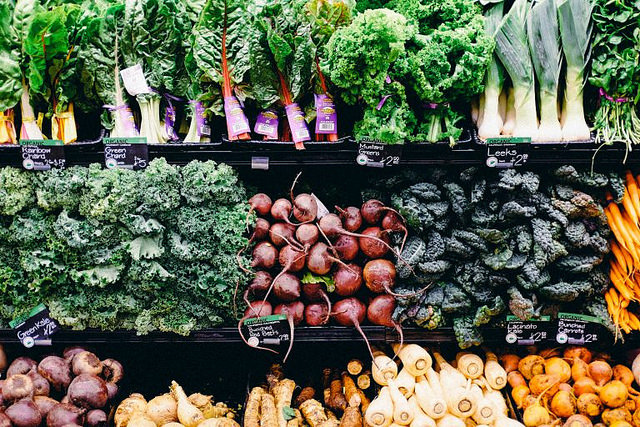It’s no secret that America’s supermarkets continue to lose share of America’s food wallet. Although the rate of share loss is not as extreme as it was 10 years ago, it remains steady and somewhat relentless. Competition is fierce as supermarkets are attacked from all sides by discount, premium and online operators — as well as many other formats.
Competition isn’t the only confounding variable. Key behavioral trends driven by changing shoppers are also impacting supermarket shopping, including a shift toward the perimeter of the store, acceleration of e-commerce and changing households and meal consumption patterns. The next 10 years promise a major restructuring of the supermarket sector, and elements of that future are already in force today. As analyzed in our recent Hartbeat Exec America’s Supermarkets in Transition, four long-term trends that are reshaping the supermarket sector, all driven by shopper behavior, include:
1. Multichannel shopping and the decline of the supermarket as the primary store
Research from The Hartman Group finds that lower prices elsewhere are the number one reason why 51% of American shoppers don’t use supermarkets as their primary store, even when it is often their nearest store. This behavior has been building for so long now that it is impossible to reverse in the near term. And cheap gasoline is only encouraging its continued possibility. Culturally speaking, Americans have become used to making dozens and dozens of different category-based prioritizations based on price vs. convenience vs. quality. They often lump together categories where price matters more than highest quality or convenience and drive efficient trips accordingly to price leaders.
2. The forgotten male shopper
FMI’s recent US Grocery Shopper Trends 2016 report finds that 79% of US adult men in 2016 are responsible for at least 50% of their household’s grocery shopping. This is up from 73% last year alone. But who is really marketing to them? Male shoppers are just as likely to go to virtually all channels, especially natural/specialty retailers and supermarkets. More important, though, is the different way in which they shop. They are much less likely to use a list than female shoppers, opening themselves to explore the retail environment more freely and to more impulse buying. And per the same FMI study, 27% of male shoppers also don’t think it’s “very important” that their primary store offer low prices. Increased involvement of men in both shopping and food prep (e.g., grilling every weekend) has injected a whole new, often less price-sensitive shopper base into fresh food purchasing, especially meat and seafood.
3. Acceleration of e-commerce trial shopping
E-commerce shopping in all categories is driven primarily by convenience. In fact, it is the new convenience vector of the twenty-first century. In food shopping, online is increasingly being seen as the ultimate convenience store but now with a supermarket level of variety. Right now, we see two primary axes of online threat to supermarket revenues:
- Mass availability of shelf-stable snacks, specialty foods and pantry staples: shoppers have gravitated to shelf-stable categories where bulk case discounts proliferate on Amazon.com through Prime Pantry and Subscribe & Save.
- Growing availability of total store (fresh and packaged) online food shopping: click-n-collect/home delivery services are expanding in top markets and creating an infrastructure for shoppers to reduce the number and/or length of store trips they take inside brick-and-mortar stores.
4. The battle for meal dollars
In the past four years, post-recession, we have quietly witnessed food retailers lose out when it comes to winning their fair share of dollar spending growth from America’s most affluent 20% of households. In fact, all Americans have increased their restaurant spending faster than their average growth in income during this period, while their grocery spending actually grew less than their income. The single most important contributing factor to this finding is the fact that most high-earning households do not live right next to a premium specialty food store. Instead, they continue to be underwhelmed and consequently do not trade up as much as their income and cultural orientation to high-quality food disposes them to do.
Overall, consumers are telling us that today’s supermarket can no longer be all things to all people in a culture of multichannel food shopping. Retailers who try to blend value with quality strategies in the same stores or in the same brand will not necessarily be rewarded in today’s food culture. Instead, consumers are increasingly seeking specialists: price specialists, quality specialists, convenience specialists. Implications and suggestions for supermarket operators include:
- Small chains and independents can redesign and provide higher quality in their fresh perimeters in key store locations
- Large chains need to defend against Amazon’s e-grocery attack on their center store, especially where Amazon Prime members are densely concentrated
- Large chains need to plan now to upgrade their fresh perimeter service mix
- Consider enhancing the merchandising mix toward higher quality as legacy-brand sales continue to drift to discount, club and online channels
- Innovating profitable fresh perimeter business models is key, and higher quality, premium distinctions are a critical tool for this to work
- Learn from specialty stores and recalibrate shopper marketing to highlight aspirational trade-up for special occasions, parties, etc. This will help your brand contemporize and build profitable trips as well—a step that’s necessary to ‘announce’ your newer premium fresh offerings, even if most shoppers’ fresh perimeter purchases are headed to everyday occasions
As CEO of The Hartman Group, Demeritt drives the vision, strategy, operations and results-oriented culture for the company’s associates as The Hartman Group furthers its offerings of tactical thinking, consumer and market intelligence, cultural competency and innovative intellectual capital to a global marketplace.
__________________________________________________
If you enjoyed this article, join SmartBrief’s email list for more stories about the food and beverage industry. We offer 17 newsletters covering the industry from restaurants to food manufacturing.
